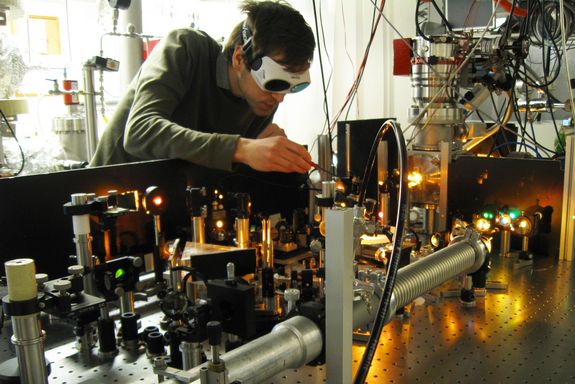What exactly happens when a molecule breaks apart? A phenomenon like this can be investigated with short laser pulses. But there is a big problem: one has to deal with very different time scales simultaneously. The electrons move so fast that they have to be studied on an attosecond time scale (an attosecond is a billionth of a billionth of a second). The heavier particles in the molecule, on the other hand, hardly move at all within an attosecond. If the distance between them increases and the molecule finally breaks apart, these dynamics can only be observed on a much larger time scale.
A method has now been developed at TU Wien (Vienna) that makes both time scales accessible simultaneously. The method uses an elliptically polarized laser pulse. For such a pulse the direction of the laser electric field rotates, much like the hand of a clock. The duration of the laser pulse is long enough to probe the comparatively slow break-up of the molecule, but the rotation of the electric field - the hand of the clock - is fast enough to serve as a time reference for the ultrafast dynamics of the electrons. Both kinds of motion are closely related. The experiment has now been published in the journal "Physical Review Letters". The TU Wien team collaborated with André Staudte from the National Research Council in Canada.
A hydrogen molecule is fragmented
"In our experiment, we shoot a laser pulse at a hydrogen molecule," says Markus Kitzler-Zeiler from the Institute of Photonics at the TU Wien. The molecule consists of two hydrogen atoms - two protons and two electrons. The electric field of the laser rips off an electron. Within attoseconds the electron leaves the molecule and flies away. As soon as an electron is missing, the bond between the remaining particles of the molecule changes, too. The distance between the two protons increases. If later during the pulse the second electron is also removed by the laser field, the two protons repel each other and the molecule disintegrates completely.
As each proton is about two thousand times heavier than an electron, the protons move much more slowly. The motion of the atoms as they are drifting apart is measured in femtoseconds or even picoseconds - thousands or millions of attoseconds. On a human scale this is still unimaginably short, but the difference to the ultrafast dynamics of the electrons is so large that it is very difficult to find a suitable clock that can measure both the rapid motion of the electrons and the slower break-up of the atomic bonds.
Polarization as a quantum clock hand
The solution was to link different timers. The fast timer is the rotation of the light field. "Just as you can add an additional hand to a wristwatch to measure shorter time intervals, we have added a quantum hand to the laser pulse," says André Staudte. Like the clock hand, the direction of the electric field of the elliptically polarized laser light – its polarization vector – rotates, but at an extremely fast speed -once every 2.5 femtoseconds. This continuous change of direction can be used to investigate how the fast motion of the electrons is related to the slow motion of the protons. As the research team was able to show, the slower proton movement can be analyzed by looking at the energy of the protons after the molecule fracture.
"We were able to show how the energy of the protons is related to the rotating motion of the polarization vector," says Markus Kitzler-Zeiler. "The exact time at which the electrons leave the molecule plays an important role: Their motion depends on the direction of the polarization vector at that moment. And the motion of the electrons then determines how the protons move. This connection enables us to distinguish unambiguously different motion patterns of electrons and protons in the molecule during its break-up."
Precision images of the quantum wave
According to the laws of quantum physics, every particle also has wave properties - this also applies to the protons in the molecule. With the new method it is now possible to measure the quantum wave of the protons with remarkable accuracy: "We can measure the quantum wave with a resolution of one picometer, which is one hundredth of the diameter of a hydrogen atom. The time resolution of our method is also very high, in the range of a few attoseconds," says Markus Kitzler-Zeiler. "Therefore, we can take extremely sharp pictures of the proton motion."
"Our experiment shows that the method works: We can use elliptically polarized laser pulses to visualize electronic and nuclear dynamics simultaneously," says Markus Kitzler-Zeiler. "We used a hydrogen molecule because it is a simple molecule, which is very well understood - but now we can also use the method for more complicated molecules. The precision of our method is sufficiently high for investigating specific questions in molecular physics," adds André Staudte.
Original publication
Additional information: https://physics.aps.org/articles/v12/149, opens an external URL in a new window
Contact
Prof. Markus Kitzler-Zeiler
Photonics Institute
TU Wien
Gußhausstraße 27-29, 1040 Vienna
T +43-1-58801-38772
markus.kitzler@tuwien.ac.at


